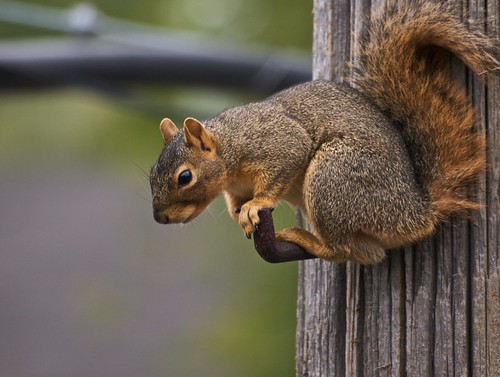Photos of Fox Squirrels – Sciurus niger – the largest tree squirrel species in North America.
I consider it a privilege to be invited into the lives of wild creatures — even animals as common as fox squirrels.
We were packing up our cameras for some city shooting when our apartment walls shook to the vibe of a 3.1 temblor. That’s only a slight exaggeration when you have five, young, stir-crazy tree squirrels galloping around the building on a ledge that’s probably designed to handle the weight of one very old and slow fox squirrel. There’s a give and a rattle that reverberates through the walls — which means just one thing: it’s spring, and a group of young adults couldn’t be happier to be out of the nest.
The Velcro Paws of Fox Squirrels
If you’ve ever had a young squirrel latch onto your sleeve — and you’ve probably only had this happen if you’re involved in some way with rehab or rescue — you know their paws feel like velcro in their capacity to cling and grip. So it’s no sweat for tree squirrels to show off their dexterity by chasing each other up and down surfaces that should, by all rights, be unnavigable . . . like the brick chimney outside our second story window. The telephone pole with its ideal gripping surface is a bit more accommodating, but their dexterity on even the most vertical plane affirms the challenge of keeping tree squirrels out of bird feeders or other places we humans have deemed off limits to squirrels.
The squirrels pictured here are likely older than 12 weeks. That’s about the age at which they glide through the trees as independent entities. The hazards for young squirrels abound — predators, wind storms, human tree trimmers, [legal or illegal] shooting, power lines, domestic cats and dogs — all threats to the security of their nests, their arboreal perches. It seems miraculous that these babies, so helpless from the start can, indeed, reach the ripe age of eight or 12 weeks, to be released from the bounds of the nest into their own personal canopies.
Rehabilitating Baby Tree Squirrels
At the wildlife hospital, we take in squirrels of varying ages, from those days-old souls, swept from their nests, to older babies left abandoned after the death of their parent. I found the wonderful images below from Audrey on Flickr showing the different stages of a squirrel’s growth in the hands of a licensed rehabber. These photos depict Gray Squirrels, also tree squirrels but distinct from the Fox Squirrels shown above. (Thanks to Audrey for making these images available under a Creative Commons license.)
Note that in California and many other areas, it is illegal for anyone but a licensed wildlife rehabilitator to take care of or keep most wild animal species. If you happen to find a baby squirrel that appears to be in need, please contact a local wildlife hospital or rehabilitator to see if intervention is, in fact, needed. Click here for a list of San Francisco Bay Area wildlife resources and information on how to find a wildlife rehabber in your area.
Feeding young animals can be tricky owing to the danger of aspiration — inhaling fluids — the effects of shock and other contingencies. Any injured or orphaned young animal should be seen by a veterinarian or qualified wildlife technician immediately or as soon as is physically possible.
There are situations where human help is definitely warranted. But there are also many circumstances when the best thing to do is leave the animal be and simply make sure (from a distance) that the parent is around to care for its young one. Again, call a wildlife hospital to find out.

Baby Gray Squirrel - by Audrey/Flickr (click image for original photo)







Leave A Comment